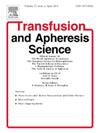Transiently acquired hemoglobin variants in patients with sickle cell disease: A case series and systematic review of the literature
IF 1.2
4区 医学
Q4 HEMATOLOGY
引用次数: 0
Abstract
Introduction
Patients with sickle cell disease (SCD) are transfused phenotypically-matched red blood cells (RBCs) for various indications. While screening for units that are sicklenegative is standard practice, the transfusion of RBCs containing other hemoglobin variants can be of concern to transfusion services and clinicians due to possible adverse events. Thus, this study aimed to review possible adverse events in patients with SCD with transiently acquired hemoglobin variants.
Methods
A case series of pediatric patients with SCD receiving chronic transfusions are presented, along with a systematic review of patients with SCD who were noted to have a transiently acquired hemoglobin variant. Data and patient outcomes were extracted and summarized.
Results
For the case series, 3 pediatric patients had transiently noted HbC peaks, with no adverse events documented. For the systematic review, 12 studies were included with a total of 75 patients with SCD. HbC was the most common hemoglobin variant in > 90 %. Other variants noted were: HbD, HbJ, HbD/G, HbG- Philadelphia, HbA2’, and HbO-Arab. The maximum peak of reported variants was < 20 % (14 % for HbC). No clinically significant adverse events were reported secondary to these transiently acquired variants.
Conclusion
Transiently acquired hemoglobin variants are commonly encountered in transfused patients with SCD, with no reported clinically significant adverse outcomes. Because phenotypic matching prioritizes donors with similar racial backgrounds, it increases the likelihood that the donor may carry hemoglobin variants. Blood centers and transfusion services should be aware of this phenomenon and avoid deferring donors with nonsickle hemoglobin variants.
镰状细胞病患者的瞬时获得性血红蛋白变异:病例系列和文献系统回顾
镰状细胞病(SCD)患者输注表型匹配的红细胞(rbc)用于各种适应症。虽然对阴性单位进行筛查是标准做法,但由于可能出现的不良事件,输血服务机构和临床医生可能会关注含有其他血红蛋白变体的红细胞。因此,本研究旨在回顾SCD患者瞬时获得性血红蛋白变异可能发生的不良事件。方法介绍了接受慢性输血的儿科SCD患者的病例系列,并对具有瞬时获得性血红蛋白变异的SCD患者进行了系统回顾。提取并总结数据和患者结局。结果:在本病例系列中,3例儿科患者出现短暂的HbC峰值,无不良事件记录。系统评价纳入了12项研究,共75例SCD患者。HbC是最常见的血红蛋白变异,占>; 90 %。注意到的其他变异有:HbD、HbJ、HbD/G、HbG- Philadelphia、HbA2 '和HbO-Arab。报告变异的最大峰值为<; 20 % (HbC为14 %)。这些瞬时获得性变异没有继发的临床显著不良事件的报道。结论瞬时获得性血红蛋白变异常见于输血的SCD患者,无临床显著不良结局报道。由于表型匹配优先考虑具有相似种族背景的供者,这增加了供者携带血红蛋白变异的可能性。血液中心和输血服务机构应该意识到这一现象,并避免推迟非镰状血红蛋白变异的献血者。
本文章由计算机程序翻译,如有差异,请以英文原文为准。
求助全文
约1分钟内获得全文
求助全文
来源期刊
CiteScore
3.60
自引率
5.30%
发文量
181
审稿时长
42 days
期刊介绍:
Transfusion and Apheresis Science brings comprehensive and up-to-date information to physicians and health care professionals involved in the rapidly changing fields of transfusion medicine, hemostasis and apheresis. The journal presents original articles relating to scientific and clinical studies in the areas of immunohematology, transfusion practice, bleeding and thrombotic disorders and both therapeutic and donor apheresis including hematopoietic stem cells. Topics covered include the collection and processing of blood, compatibility testing and guidelines for the use of blood products, as well as screening for and transmission of blood-borne diseases. All areas of apheresis - therapeutic and collection - are also addressed. We would like to specifically encourage allied health professionals in this area to submit manuscripts that relate to improved patient and donor care, technical aspects and educational issues.
Transfusion and Apheresis Science features a "Theme" section which includes, in each issue, a group of papers designed to review a specific topic of current importance in transfusion and hemostasis for the discussion of topical issues specific to apheresis and focuses on the operators'' viewpoint. Another section is "What''s Happening" which provides informal reporting of activities in the field. In addition, brief case reports and Letters to the Editor, as well as reviews of meetings and events of general interest, and a listing of recent patents make the journal a complete source of information for practitioners of transfusion, hemostasis and apheresis science. Immediate dissemination of important information is ensured by the commitment of Transfusion and Apheresis Science to rapid publication of both symposia and submitted papers.

 求助内容:
求助内容: 应助结果提醒方式:
应助结果提醒方式:


